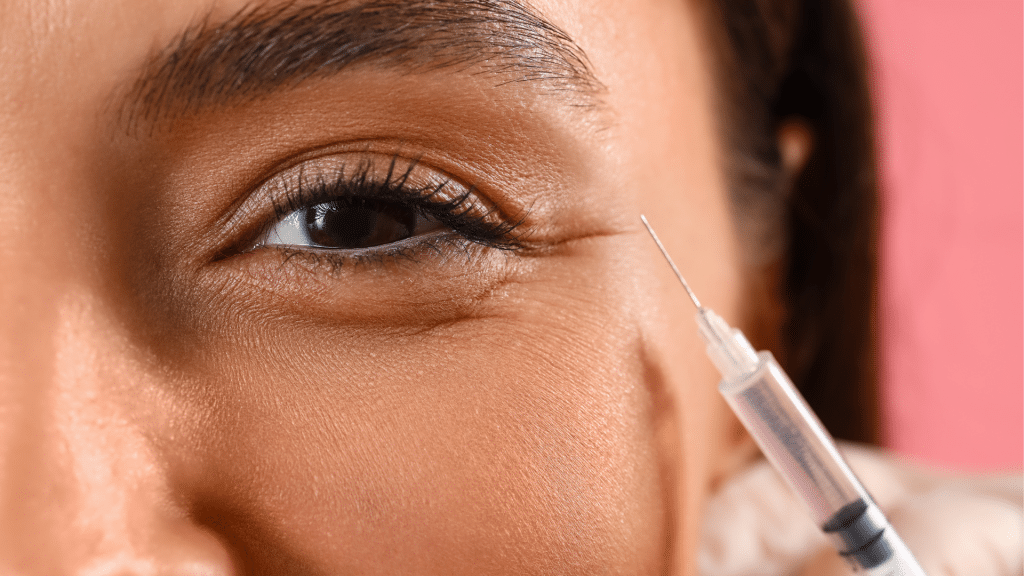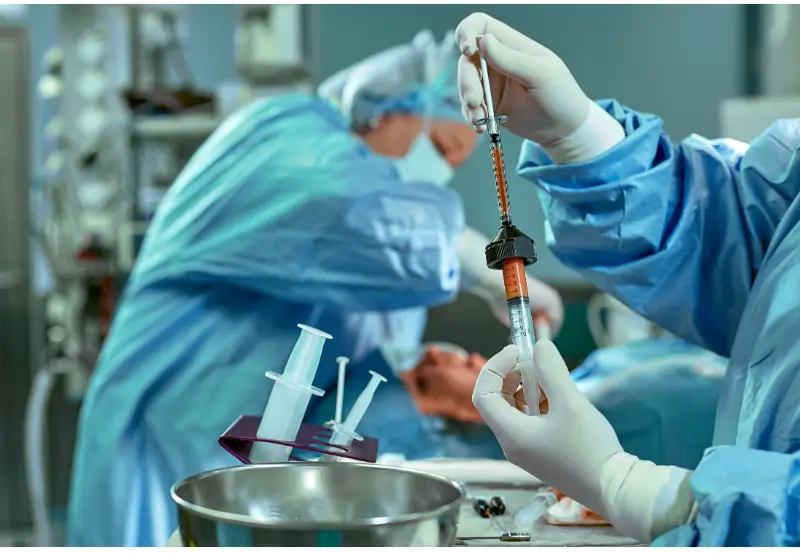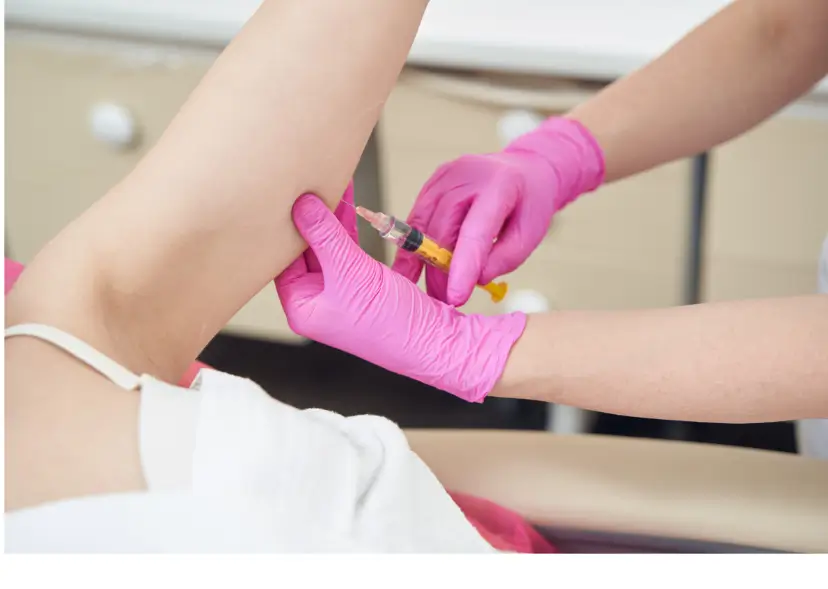The tear trough area, a common concern in facial aesthetics, has seen a significant rise in non-surgical interventions. A systematic review published in the Aesthetic Surgery Journal reported high patient satisfaction rates with hyaluronic acid filler injections for tear trough rejuvenation, with short-term satisfaction at 84.4% and long-term at 76.7%.
Restylane, a hyaluronic acid-based dermal filler, is particularly noted for its efficacy in the tear trough region. It reduces the appearance of hollows and dark circles and promotes collagen production, offering a dual benefit of immediate correction and long-term skin improvement.
This article will examine how Restylane explicitly targets the delicate under-eye area. We’ll discuss its application, benefits, and what makes it a preferred choice for those looking to rejuvenate their appearance with minimal downtime.
Key Takeaways
- Restylane is an effective dermal filler for addressing tear trough deformities, such as under-eye hollows and dark circles.
- Understanding the anatomy of the tear trough area and the common causes of these issues is crucial for successful treatment.
- Specialized injection techniques and patient selection criteria are essential for safe and effective Restylane tear trough correction.
- Managing patient concerns and setting realistic expectations is essential for achieving optimal treatment outcomes.
- Restylane plays a significant role in enhancing periorbital aesthetics and improving overall facial harmony and balance.
About: Medical Spa RX provides premium products at the best prices for medical practices. If you’re looking to buy Restylane online for your practice, the sales representatives at Medical Spa RX can guide you.
Understanding Tear Trough Deformities

The tear trough area is a crucial part of facial anatomy. It includes three prominent periorbital hollows: the septal confluence, orbital rim hollow, and zygomatic hollow. These areas are essential because they frame the undereye zone.
Under-eye hollows and dark circles are often caused by aging, volume loss, and fatigue. As people age, their skin loses collagen and fat, which causes the under-eye area to sink and show hollows.
Moving from why under-eye hollows and dark circles appear, let’s focus on how tear-trough deformities affect our appearance. These problems can make the eyes look sunken and cast shadows below them.
Restylane for Tear Trough Correction

Restylane injections fill under eye hollows and fade dark circles. It makes faces look younger and fresher.
Restylane dermal fillers are a game-changer for addressing facial wrinkles, volume loss, and especially tear trough deformities. They bring back fullness to the under-eye area, making you look refreshed.
Using Restylane dermal fillers for tear trough correction offers many benefits. This treatment can quickly fix under-eye hollows and dark circles, making the face look younger and more rested.
Restylane works wonders for under-eye hollows and dark circles by adding volume where needed most. This dermal filler is packed with hyaluronic acid to correct age-related volume loss and targets the tear trough area.
Injection Techniques and Considerations
Specialized injection techniques for the tear trough area are essential. These methods effectively fix under-eye hollows and dark circles.
- The vertical subperiosteal depot technique (VSDT) is a go-to method. This involves placing Restylane directly on the bone beneath the eye areas to improve hollows and darkness.
- The linear threading technique uses a careful, continuous line of Restylane filler. This fills in the under-eye area smoothly.
- Supraperiosteal injection targets the deeper layers. This ensures more lasting effects and natural-looking results.
- Pre-treatment evaluation is crucial for success. Doctors should carefully assess each patient’s needs to determine the best approach.
- At first, small amounts of Restylane are used. Doctors can add more if needed to avoid overfilling.
- Proper aftercare advice helps patients get better faster. After getting fillers, they need to know what to do and what not to do.
- Each case study shows different ways doctors use these techniques effectively, showcasing their skills in rejuvenation around the eyes.
Filler injections for the tear trough area, like Restylane, can cause bruising, known as hematoma. This is a common issue but still essential to consider. Each face is unique, so the chance of getting a hematoma varies from person to person.
Managing Patient Concerns and Expectations

Patients often worry about the look of under-eye hollows and dark circles. These concerns push them to seek tear-trough correction with dermal fillers. Here’s a closer look at common patient concerns:
- Fear of Unnatural Results: Many fear their face won’t look like theirs after the treatment. They want to ensure they don’t look overdone.
- Worry Over Pain and Side Effects: The thought of needles near the eyes can be scary. Patients often ask how much it will hurt and what side effects might happen.
- Concerns About Recovery Time: People lead busy lives and want smooth downtime. They ask how soon they can return to daily activities.
- Questions On Longevity of Results: How long will the improvements last? Patients ask this question to know if it’s worth it in the long run.
- Anxiety Over Potential Risks: Although risks are rare, knowing them is essential for patients. They sometimes have anxiety about complications that could occur.
- Uncertainty About Needing More Treatments: Some wonder if they’ll need more sessions to get the desired look. The idea of multiple treatments can be daunting.
- Doubts About Cost vs. Benefit: People weigh the cost against the expected benefits of any cosmetic procedure. They hope for a good balance between what they pay and how much better they will look.
Restylane tear trough treatments effectively correct under-eye hollows and dark circles, offering patients a less invasive option than surgery. With minimal downtime, most see swelling and bruising go down quickly.
Restylane Tear Trough Procedures
Using Restylane in the tear troughs fills under-eye hollows and fades dark circles. It restores a fresh look to your face, making you appear more awake and youthful.
Case studies show dermal fillers, especially hyaluronic acid, work well for tear trough deformity. Young patients with clear hollows under their eyes often see great success. This success comes from picking the right people for the treatment and using safe techniques.
Transitioning from the impactful experiences shared in case studies, we see how Restylane is used for periorbital rejuvenation. This filler is more than a temporary fix; it targets the root of under-eye hollows and dark circles.
Conclusion
Restylane tear trough treatments light up the area under your eyes. They fill hollows and smooth dark circles, giving you a fresh look. This simple method uses special fillers to bring back volume and youthfulness without surgery.
Many people have seen great results, feeling more confident in their appearance. With Restylane, brightening under-eye shadows becomes an easy fix for looking refreshed and awake.
FAQs
1. What is Restylane tear trough treatment?
It’s a quick fix in which a gel is injected under the eyes to remove dark circles and hollows.
2. Does the Restylane tear trough treatment hurt?
You might feel a little pinch, but they use numbing cream to make it as comfy as possible.
3. How long does the result last after getting the treatment?
The fresh look under your eyes lasts for about 6 to 12 months before you need another visit.
4. Can anyone get this under-eye treatment done?
Most people can, but you’ll chat with a doctor first to ensure it’s right.
5. How fast will I see changes after my Restylane tear trough procedure?
You’ll notice things looking better down there almost right away, give or take a few days for any puffiness to calm down.
References
Gorbea, E., Kidwai, S., & Rosenberg, J. (2021). Nonsurgical Tear Trough Volumization: A Systematic Review of Patient Satisfaction. Aesthetic Surgery Journal, 41(8), NP1053–NP1060. https://doi.org/10.1093/asj/sjab116
Jiang J, Wang X, Chen R, Xia X, Sun S, Hu K. Tear trough deformity: different types of anatomy and treatment options. Postepy Dermatol Alergol. 2016 Aug;33(4):303-8. doi: 10.5114/ada.2016.61607. Epub 2016 Aug 16. PMID: 27605904; PMCID: PMC5004220.
ResearchGate. (n.d.). Anatomy of tear trough deformity [Image]. Retrieved from https://www.researchgate.net/figure/Anatomy-of-tear-trough-deformity_fig2_235398881





















